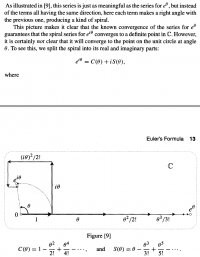Hello,
I am reading Visual complex analysis book and got stuck at page 12 where the author derives Euler formula from a power series as shown below:

Basically figure [9] shows that real numbers are horizontal while imaginary ones are 90 degrees apart. However I don't understand how the author derives C(0) and S(0). For example, why S(0) doesn't contain 2!θ2 element - on figure [9] we can see 2!iθ2? Likewise why it contains 5!θ5 while on fig [9] we see this is a real number?
Thanks
I am reading Visual complex analysis book and got stuck at page 12 where the author derives Euler formula from a power series as shown below:

Basically figure [9] shows that real numbers are horizontal while imaginary ones are 90 degrees apart. However I don't understand how the author derives C(0) and S(0). For example, why S(0) doesn't contain 2!θ2 element - on figure [9] we can see 2!iθ2? Likewise why it contains 5!θ5 while on fig [9] we see this is a real number?
Thanks
